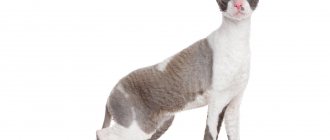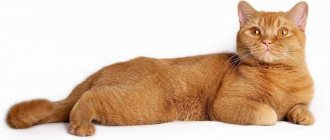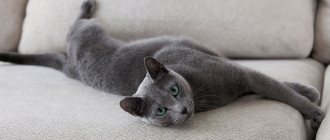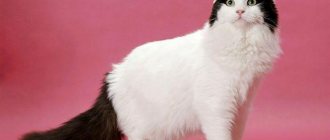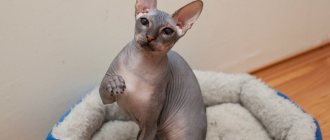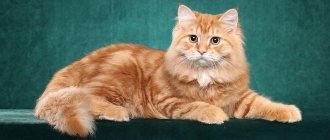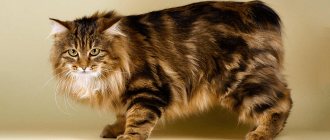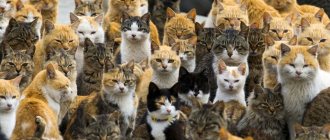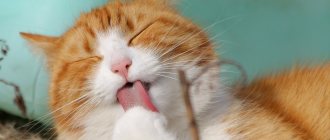Features of fluffy cat breeds
Long-haired cats have a special coat structure: the hairs are quite dense and the undercoat is thick. During seasonal molting, animals are forced to lick dead hairs every day. This routine procedure helps to renew the coat, but most of the hairs remain in the stomach, which causes a lot of trouble. Owners should provide pets with sprouted oat or wheat sprouts to remove hairballs.
Long-haired fluffies have a tendency to develop tangles. Regular licking and combing of the hairs will help solve the problem.
Free range can also ruin the appearance of furry beauties. Dust, debris, thorns, dry leaves are what cats often return from a walk with.
Certain breeds of cats shed all year round, which adds to the worries of their owners. In other breeds, the coat grows back darker after clipping, which leads to disqualification at the show.
The high likelihood of allergic reactions in family members is another feature of fluffy cat breeds. During the molting season, hairs cover literally everything around, clumps of fluff get stuck in corners and under furniture, which complicates cleaning the room. Such animals will have to comb their fur every day. By the way, a robot vacuum cleaner will take on some of the routine work and make life much easier for cat owners.
Advantages and disadvantages
Dense and thick wool has its advantages, but it is not without its disadvantages.
A warm coat protects the animal from the cold, but in summer it can become a real problem. If the owner neglects hygiene rules, the animal runs the risk of developing skin diseases. To maintain an attractive exterior, you will need hard brushes, slicker brushes, combs, and furminators.
In some cat breeds, the fur is prone to fading, so owners should ensure that their pets do not walk under the scorching sun. Under the influence of ultraviolet light, the hairs become dry and brittle.
Long-haired cats often resist when the owner tries to comb their coat, which makes grooming more difficult. Few of the cat family like water treatments, which cannot be avoided if the pet is free-range. Ticks and fleas hide in a thick fur coat and are often invisible. To remove fleas, medications are used that have a negative effect on the coat: the hairs lose their elasticity, become dull and brittle.
The history of long-haired cats
The cat was domesticated almost ten thousand years ago in the Fertile Crescent (modern-day Iran). Throughout the history of the world, they were sung and deified, burned at the stake of the Inquisition and persecuted, cherished and cherished. Today, these pets are full-fledged companion animals living next to people.
Long-haired beauties became known to modern man later than their short-haired counterparts.
There are at least four versions of the appearance of cats with long hair in the modern world.
The first story tells that in the sixteenth century, the famous aristocrat and traveler Pietro Della Valle brought several unusually fluffy cats from Persia as a gift to the Pope. The French became interested in the curiosity. Cardinal Richelieu himself patronized extraordinary handsome men and made them famous throughout Europe.
Siberian cat
According to the second version, initially two species of oriental cats with longer-than-usual hair appeared in Europe. And on their basis the Persian cat was bred.
According to the third assumption, the long-haired beauty was brought to Europe from Russia, a country of severe frosts.
The fourth, more plausible, says that long hair appeared in domesticated oriental cats from natural crossing with the wild cat Manul. From him they could well have gotten a flat muzzle, huge round eyes and long thick fur.
Norwegian cat
Scientific theory leans towards the version that the first long-haired cat appeared in Europe more than four hundred years ago. Two types of cats with long hair were brought from Turkey. One species is described as similar to the modern Angora, the second to the Persian cat.
All these theories have a right to exist, but they were and remain only assumptions. Most likely, they owe the appearance of long hair in domestic pets to wild steppe and desert Asian cats, whose habitat in the sixteenth century was the Middle East.
Siberian cat
From France the Persians came to Italy and England. Breeders bred the first European Longhair breed. Since then, there have been two types of long-haired pets. Angora - with an elongated head, flexible and graceful body and silky coat. And massive, heavy and short cats with round heads, flattened noses and long hair with a thick, powerful undercoat - the Persian type.
Angora cats have been known in Persia, India and Afghanistan since the ninth century. Their long snow-white fur and clear blue eyes have always been appreciated.
White Turkish Angora
In the early Middle Ages, cats were treated with reverence and respect; they more than once saved Europe from hordes of rats and mice, and helped stop the plague. These long-haired beauties lived in monasteries with the nuns.
But the times of the Inquisition came and many recently beloved animals were thrown into the fire. Cats with black and red fur were especially affected.
Black Angora
Long hair is undoubtedly the result of natural mutations, and the reason for it was the rather cold climate in the areas where these animals appeared.
The systematization of breeds and systematic selection work in the feline world began quite recently, which is why the history of the origin of beauties with long hair is vague and foggy.
Furry breed categories
Cat breeds receive official recognition after passing certification in one of the felinological communities. Animals receive metrics, pedigree and documentary evidence of origin. The exterior must comply with the breed standard. Only a complete package of documents gives the right to selection and participation in exhibitions.
There are more than 700 special species of cats in the world, but international organizations recognize only a few dozen:
- FIFe (World Cat Federation) recognizes 42 breeds.
- European WCF - 70 breeds;
- American CFA Association - 40 breeds.
Breeding work is ongoing, so some resistant phenotypes will periodically receive official recognition.
According to FIFe
According to FIFe, furry varieties include categories I and II, which include the following breeds:
- American Longhaired Curl.
- Balinese cat.
- Burma.
- British.
- Himalayan cat.
- Maine Coon.
- Neva Masquerade.
- Norwegian forest.
- Persians.
- Ragdoll.
- Siberian cat.
- Turkish Angora.
- Turkish van.
- Exotic.
Ragdoll
According to WCF version
According to WCF, furry cat varieties include breeds of categories 1 and 2:
- Long-haired Burmilla.
- Karelian Bobtail
- Kurilian Bobtail.
- Laperm.
- Munchkin.
- Nibelung.
- Oriental.
- Ragamuffin.
- Selkirk rex.
- Somali cat.
- Tiffany.
- Ural rex.
- Highland fold.
- Japanese Bobtail.
Ragamuffin
According to CFA
The CFA recognizes the same cat species as the WCF and FIFe with the exception of: American Bobtail, Ojos Azules, Pixie Bob.
TOP 17 long-haired breeds
Let's look at the most beautiful breeds of long-haired cats.
Persian cat
In fact, from the point of view of felinologists, the only long-haired breed. One of the very first with long hair. The history of occurrence has not been established, but it may have a natural origin. It first participated in an exhibition in 1887 in Great Britain, practically the first breed in the European felinological system.
The coat is very long, fine and silky with a well-developed undercoat. The colors are varied, the eye color is golden, blue (for white colors), green.
The character is calm and flexible. Phlegmatic, but willful and irritable. Not recommended for families with children. The price of a pet-class kitten in Russia is from thirty thousand, individuals for breeding and show animals are much more expensive, up to one and a half thousand dollars.
Read more in the article about Persian cats.
Read about the most beautiful cats in the world.
Turkish Angora
One of the most ancient natural breeds. It was also brought to England from Turkey in the sixteenth century. It has long been considered a species of Persian. Numerous crossings with these long-haired cats significantly reduced the purity of the breed.
The natural gene pool after the Second World War was restored in the fifties of the last century; the ancestors of the new Turkish Angora were a pair of cats preserved in the Ankara Zoo. The breed was recognized only in 1973 in England, only snow individuals with blue or heterochromic eyes.
The Angora differs from the Persian cat in its more graceful and elongated body, grace and flexibility. Other colors - red, brown, blue and cream, black, tortie, tabby with green, amber or brown eyes - were approved later.
The Angora's character is also phlegmatic, but they are more friendly and affectionate animals. There is no Persian willfulness in them. Perfect for living in a large family with children.
The average cost of these animals in the world is from three hundred to eight hundred dollars, depending on the class of the animal.
Read about Turkish Angoras on the Mister Cat portal.
Balinese cat (Balinese)
Sometimes this animal is called the Siamese longhaired cat because of its characteristic color-point color of various colors - blue, cream, lilac, red, chocolate, tortie and tabby. In some systems, the long-haired variant of colors other than the standard Siamese is called Javanese. The breed was officially recognized in 1961, and is now recognized in almost all felinological systems.
These medium-sized cats with not very long hair are very sociable, friendly, and attached to people.
As a pet, Balinese can be bought from twenty to forty thousand rubles. For breeding and exhibition careers, it is better to purchase kittens from nurseries in the USA, Canada and the UK; their price is about one and a half thousand dollars.
Read more in the article about Balinese.
Burmese cat (Sacred Burma)
One of the oldest cat breeds. Buddhist monks considered them the guardians of the souls of the dead. There is a beautiful legend about the appearance of these cats. It is connected with the death of the guardian priest from the Lao Tsung Temple. The beloved cat of the deceased Singh touched the body of the owner and was transformed - his fur became golden, on his face, paws and tail - black, the very tips of his paws were shod with white “socks”, and his eyes acquired the color of heavenly blue. The monks dealt with the attackers, believing that the Buddha himself was their patron.
Later, in 1919, a pair of animals were given as a gift by the monks to French officers. This is how this sacred breed ended up in Europe. Registered in France in 1925.
Nowadays there are several different colors - red, blue, cream, chocolate, lilac, siale, but always color point.
Playful and affectionate, somewhat obsessive and jealous, Burms do well in a large, friendly family with children.
The cost of a pet-class kitten is from twenty thousand rubles, breeding and show animals are about seventy. Individual breeding specimens from French nurseries are sold much more expensive.
We recommend reading the article about Burmese cats.
Siberian cat
The Siberian cat is a Russian longhaired breed. Known to people since the sixteenth century under the name Bukhara.
There are many theories about the appearance of this natural variety. Most likely, this is one of the types of eastern cats that came to Siberia along with settlers or was brought by merchants, and mutated under the influence of harsh climatic conditions. During the Great Patriotic War they actively helped people fight rodents. It was these cats that were brought to Leningrad after the blockade was lifted to kill rats.
The breed began to be selectively bred in 1986. The standard allows any color of long and thick coat with excellent undercoat, except chocolate, lilac, Abyssinian ticked. A distinctive feature of these animals is the letter “M” on the forehead.
The smartest and kindest pet is unusually beautiful and often has small tassels on its ears. Unpretentious in food, care consists of weekly combing of the long, thick coat, which does not have a tendency to form tangles. They are ubiquitous and loved by humans.
The cost of the Siberian in Russia is small, but abroad this animal is valued dearly, from five hundred to a thousand dollars.
Read about Siberian cats.
Norwegian Forest Cat
Another of the oldest natural breeds, the Norwegian Forest Cat has long been present in the myths and tales of Northern Europe. They were considered companions of the Viking gods Thor and Freya. The first scientific description belongs to the naturalist Frins and dates back to 1599. They always lived on farms and were considered simple yard cats. First presented at an exhibition in Oslo in 1938.
During the Second World War, the breed almost completely died. It was restored with difficulty by 1970. Through the works of the Norwegian felinologist Nordan, a society for the preservation of the Norwegian Forest Cat was created.
The Norwegian Forest Cat is not very different in appearance from the Siberian cat. Officially declared an animal of Norway in 1977. The oldest breed of pets with cute tufts on their ears has long and reliably won the hearts of people with their calm, Nordic character, friendliness and excellent qualities as a hunter.
Distributed mainly in Europe. You can buy a kitten there from two hundred to a thousand dollars, depending on the class of the pet.
Read more in the article about Norwegian forest animals.
Maine Coon (Raccoon cat)
The Maine Coon is an American breed of long-haired cat, known to mankind since 1891. This animal is the result of natural hybridization. It is not known for certain who its ancestors are; perhaps there was a lynx in its distant ancestors. There is even a version that the coon is the result of crossing a European shorthair cat and a raccoon, but this explanation is completely unscientific.
The result of a natural gene mutation, although it has an unusual external, outstanding appearance and significant size, can hardly be considered successful. This pet is often born with congenital pathologies of the heart, kidneys, lower jaw and teeth, which is associated with the physiological characteristics of the body structure.
Too massive jaws also cause problems with the spine. It has long, thick hair that requires careful and constant care. There are a variety of colors. It has ears with remarkable long tufts and a massive, protruding lower jaw.
He certainly won the love of cat lovers with his exotic appearance. It should be remembered that its maintenance is associated with daily careful care.
You can buy a Maine Coon kitten in Russia from twenty to one hundred thousand rubles, depending on the class of the pet.
Neva masquerade cat
The Neva Masquerade is the result of crossing the Siberian and Siamese cats. The Russian breed appeared in the sixties of the twentieth century in Leningrad.
Despite the fact that many felinological organizations are in no hurry to recognize the young breed, it is very popular. First of all, because of the characteristic color-point color, large blue eyes and long shiny fur, which is considered hypoallergenic. This is unlikely to be the case, but cases where allergy sufferers get along well with this pet are indeed not rare.
This very friendly, intelligent, calm and very attached creature is perfect for families with children.
The cost of a kitten is slightly higher than a standard Siberian - up to one and a half thousand dollars a show animal is sold.
Read more in the article about Neva masquerade cats.
Somalia
This breed was developed in the United States of America in the late fifties of the twentieth century from the Abyssinians. According to felinologists, Persians and other long-haired cats did not take part in selection. However, the Somali is a long-haired variant of the Abyssinian cat.
First presented at the exhibition in 1963, the breed standard was approved in 1967.
This is a graceful, very large animal with long, thick hair, large almond-shaped eyes and ears with tassels at the tips. All colors are ticked and varied - sorel, blue, lilac, fawn, cinnamon, ruddy, cream, wild.
The Somali has a friendly and open character, intelligent and playful. They need long walks and large spaces for an active lifestyle. Perfect for a family with children living in a country house.
You can buy a kitten as a pet in Russia from thirty to fifty thousand rubles; exhibition and breeding animals are much more expensive.
Read more about Somalia.
Turkish Van
This cat also comes from Turkey and has a natural origin. The breed got its name from a lake in Anatolia, where it arose and developed for a long time without interbreeding with other species.
In 1955, several individuals came to the UK and felinologists began purposefully working on selection and approval of the breed, which occurred in 1969.
These animals are now registered in almost all felinological systems and are very popular all over the world. They are similar in type to Angora, but have a stronger build. There are colors - golden, white, blue, cream, tortoiseshell. The eyes are blue in animals with a primary white color, heterochromia (multi-colored) is possible, yellow in all others.
The most common color is solid white with red spots on the face; there are marbled ones. A distinctive feature is a snow mark on the forehead and white ears on the outside.
Turkish Vans are excellent fishermen and swimmers, and their coat has excellent water-repellent properties. They do not tolerate loneliness well. Recommended for large families in which one of the household members is always in the house. The cost of a kitten varies from four hundred to a thousand dollars depending on the class (pet, breed, show).
Nibelung
This charming "Child of the Mists" looks quite similar to the long-haired Russian Blue, but is an independent breed, bred and registered in the United States of America in 1987. They are distinguished by their semi-long coat of amazing color - the only one allowed - deep blue with light tipping at the ends of the hair. Because of this, the animal appears to be surrounded by a silvery haze. There can also be only one eye color - emerald. Various shades of it are allowed, but if yellowness predominates, this is a disqualifying sign.
These delicate and gentle animals are very silent, they practically do not speak, and can “meow” silently. They treat one single owner with love, trepidation, care and jealousy, but throughout their lives they take care of everyone in the house. They really don’t like quarrels, loud screams and noise.
They are not at all demanding in terms of maintenance and feeding; you just need to make sure that their amazing fur does not fade in the sun.
This young breed, although initially not appreciated by experts, is gaining popularity every year. Felinologists predict a great future for this graceful cat with an amazing temperament.
In Russia you can hardly find a real Nibelung. It makes sense to buy an exhibition animal or a breed-class cat for breeding from nurseries in the United States of America, Canada, and Europe. Its cost will be high - not less than ten thousand dollars. Pets are practically not sold as a pet class. The price in Russia for this animal starts from a thousand dollars.
Himalayan cat
It is the result of crossing a Persian and a Siamese. The breed was developed in the United States of America in 1947. Today it is recognized by all feline systems.
This is a long-haired animal with color point and tabby point colors in various color variations (sial, blue, red, lilac, cream, chocolate). Very calm, friendly and loyal, although it requires constant human attention.
These cats are highly valued all over the world. The price of a kitten ranges from three hundred to one and a half thousand dollars, depending on the purpose of acquisition and the quality of the pedigree.
Read more in the article about the Himalayan cat.
Cymric cat (Cymric, Welsh cat)
Cymrik is a relatively recently developed breed. It was originally formed as a result of natural mutations in a Welsh county. Officially registered in Canada in 1970, in the United States in 1989. It is often called the Longhaired Manx.
This medium-sized animal seems much larger due to its semi-long double coat - the undercoat is very thick, such a coat is sometimes called “stuffed”. The main difference from other breeds is the absence of a tail; only a few caudal vertebrae are allowed.
The colors are varied - solid, smoky, tabby, color point, bicolor.
Loyal, affectionate, friendly and very hardy pets are touchy. If there are children in the family, they should play delicately with the cat and not offend it..
For Russia, Kymrik is a great rarity. The price of a kitten in nurseries around the world is from four hundred to one and a half thousand dollars.
Japanese Longhaired Bobtail
This is the oldest natural breed of Japanese cat with a short, curved tail.
Japanese Longhaired Bobtail
There is a beautiful legend about the origin of this breed. The ancient Japanese believed that all the evil in the world was contained in the tail of the cat deity Necromancer. Cats were persecuted for a long time, and when their help was needed in exterminating rodents, people began to take them into their homes, having previously docked their tails. As a result of centuries-old mutations, tailless individuals began to be born.
Japanese Bobtail
The breed was recognized in the United States of America in 1978. There are two versions - with short and long hair. These sweet pets have a wonderful, friendly and trusting nature and are highly prized.
The breed is not common in our country. In the world, the cost of a Japanese bobtail varies from five hundred to two and a half thousand dollars.
Ragdoll
This wonderful fluffy pet with the funny name “Rag Doll” was bred and registered in the United States of America in 1965. Breeder Annie Baker crossed an Angora and a Burmese cat and got kittens with unusual colors and a calm, even phlegmatic character.
The breed got its name from the ability of cats to completely relax their muscles when a person picks them up.
This large pet (males weigh up to ten kilograms) has three types of colors - color-point, bicolor and mitted (gloved).
Because of its wonderful character, the Ragdoll is in great demand around the world, although the breed is more widespread in America and Great Britain.
Needs special care due to low pain threshold and muscle relaxation. She is overly attached to her owner, demands communication from people, and loves to talk with family members.
In Russia, a pet “for the soul” can be purchased at a price of ten to sixty thousand rubles; purebred animals from American nurseries are much more expensive.
Ragamuffin
The Ragamuffin breed was bred by the same American breeder as the Ragdoll. And it was obtained by crossing the latter with ordinary street long-haired cats. That's why it's called "Ragged Man". This is a large breed (up to ten kilograms in weight for males) and comes in various colors except color point.
Not long ago, Ragamuffin was recognized by the felinological federations CFA, ACFA and WCF. Until mid-2030, mating with all long-haired breeds is allowed.
Due to the peculiarities of its temperament, this animal evokes admiration; it is not for nothing that its first name is “Cherub”. Very attached to a person, absolutely trusting and not touchy.
It is not widely popular due to its low distribution. You can buy "Raggedy" only in a few nurseries in the United States of America, Canada, Great Britain, and Japan. Kittens cost up to eight hundred dollars.
Laperm
This "permed" cat is characterized by funny curls. In the short-haired version, the breed was approved only in two American systems in 1987. Has a variety of colors.
These animals are very affectionate, sociable and great for playing with children. You can buy a kitten only in a few nurseries in the United States of America at prices ranging from four hundred to two thousand dollars.
The breed is today recognized in TICA (2002), CFA (2008), ACFA (2011). Afterwards it was also approved by FIFe and WCF and an international standard was developed.
Read more in the article about lapermas.
The most beautiful fluffy cat breeds
According to breeders and cat owners, the most beautiful breeds are British, Maine Coon, Angora, Neva Masquerade, Persian, Ragdoll, and Scottish Fold.
The most affectionate
Cats with the most affectionate and flexible character: Ragdoll, Neva Masquerade, British, Persian, Burmese, Maine Coon, Oriental.
With a flattened muzzle
Year after year, cats with flattened faces top the ranking of the most popular breeds: Persian, Scottish Fold, British, Himalayan, and exotic.
Which don't shed
Non-shedding cats are a myth. Such breeds do not exist in nature. Animals shed dead hairs regardless of the length of their fur. However, cats with coarse or curly fur shed the least: rexes and representatives of the Siamese-Oriental group. Bengals, Nibelungs and Tiffanys shed slightly.
Chantilly Tiffany
General characteristics and standards of long-haired breeds
International felinological associations classify only Persian cats as long-haired breeds, which are recognized by absolutely everyone. Some systems divide it into Persian, Persian two-color and Persian color-point. Other breeds with long hair are classified as semi-longhaired.
Neva Masquerade
The description of the modern type of Persian cat, as the most characteristic representative of long-haired breeds, is given on the basis of European standards:
- Head. Large, massive, round in shape with well-developed cheeks and a convex forehead. The nose is short and wide, snub-nosed, the deflection of the nasal bridge is large, and the “stop” is pronounced. The nose is slightly protruding. The chin is strong and heavy, lies in the same plane of the muzzle, sometimes protruding slightly forward. The jaws are strong, well developed with a correct bite. A small snack is allowed, no more than three millimeters. The upper lip is slightly raised and gives the impression of a smile. The tear lines are not very deep.
- Neck. Short, strong, wide.
- Eyes. Large and round, located in a straight line without tilting. Wide open. Due to them, the facial expression is characteristic - “baby face”. The eye color must be a clear and pure shade corresponding to the color of the coat. Mostly orange to copper, green (chinchillas), blue (white colors).
- Ears. Small, with rounded ends. Wide apart, low seating.
- Body. Large or medium size. The back is wide, level, the body is powerful, but compact. The belly and chest are rounded.
- Paws. Short, powerful, muscular, with well-developed feathering between the toes.
- Tail. Short, wide, evenly pubescent, should reach the floor from a standing position.
- Wool. Thin, silky, shiny. The undercoat is dense and dense. Due to it, the main hair appears far away from the body. Faded and electrified wool is not allowed. On the paws there are “pants” and “sleeves”, on the neck there is a “collar”, a “jabot” on the chest, the tail is pubescent like a “plume”.
- Colors. Any - solid (solid), mixed (bicolor, cake), tabby, color-point, shaded (smoky).
- Weight. Females are smaller than males. Up to six to eight kilograms.
- Matings. Only intrabreeds.
Disqualifying signs:
- Medallions and spots in solid and shaded colors.
- Violation of the shade of the nose and paw pads in accordance with the color.
- Tail creases.
- Violation of eye color (must match color).
- Weak legs, deformation of the back and chest.
The nuances of keeping cats of fluffy breeds
A luxurious fur coat requires careful care. Breeders advise accustoming a kitten to hygiene procedures from an early age, so that in the future water treatments and brushing will not cause aggression.
Individuals with a thick undercoat should be brushed twice a week. A furminator will be a cat owner's best friend. The tool deals with fluff in no time, and cats do not perceive such combing as an execution. On the contrary, most pets like it when their fur coat is combed with a furminator.
It is better to brush Persians with a slicker brush due to the special structure of their coat. The tool copes well with the airy fur of Persian cats.
For curly-haired felines, stiff brushes and combs are suitable. It is important to use the tool carefully so as not to damage the hairs.
It is not advisable to neglect the procedure for combing fluffy long-haired cats, because their hairs are prone to tangling, and then the tangles are difficult to comb out; all that remains is a haircut.
Veterinarians advise adding vitamin and mineral complexes to the diet to maintain healthy coat and skin.
Representatives of the Tiffany breed have a unique coat structure that requires minimal grooming. The structure of the hairs is thin and velvety, so they do not tangle and do not catch dust and dirt thanks to the special enveloping coating.
Persians need more careful care, because animals often lick shedding hairs that clog their stomach. Cats need to be given medications to remove the lumps.
Tendency to disease
Representatives of aboriginal breeds (Siberian cat, Maine Coon, Turkish Van, Angora, Neva Masquerade) can boast of enviable health. They rarely suffer from infectious diseases and are not susceptible to genetic pathologies.
Hybrid breeds, created by crossing several breeds, are often prone to hereditary diseases. For example, Scottish fold cats suffer from pathologies of the cardiovascular system, have problems with the kidneys and teeth.
A whole bunch of genetic diseases have been discovered in Persians. The nose and eyes are primarily affected due to the special structure of the skull. Cats have difficulty breathing due to an abnormal structure of the nasal septum. Animals suffer from severe diseases such as:
- renal failure;
- viral rhinotracheitis;
- hypertrophic cardiomyopathy;
- retinal atrophy.
Exotics inherited from the “Persians” a tendency to conjunctivitis.
Orientals suffer from gastrointestinal diseases, bronchial asthma, heart pathologies, retinal atrophy, and strabismus.
Balinese cats are diagnosed with congenital heart defects.
Breeds under recognition
In the felinological world, there are always animals that experts are still working on and breeds that have not yet received sufficient distribution. Many are registered only as experimental ones, others are just establishing the standard, and others are still developing the necessary gene pool.
Chantilly Tiffany
This long-haired breed is quite old and was widely known at one time. But by the eighties of the last century, breeding work had practically ceased. It is currently in the recovery stage.
These are medium-sized animals with long hair in the colors chocolate, cinnamon, fawn, lilac, and blue.
Very smart cats with a calm and easy-going character, who do not tolerate loneliness well and are wary of strangers.
You can buy kittens in nurseries in America and Canada for about a thousand dollars.
Read the article about Chantilly Tiffany cats.
York Chocolate cat
This animal was born by accident in the United States of America in 1983. It is distinguished by its amazing chocolate color long coat.
Available in three colors - chocolate, lilac and chocolate with a lilac tint. Most likely, Persians and Siamese were involved in the origin of the breed. The difficulties in developing the breed are that many kittens are born with tabby characteristics. Although the breed has already been approved by the largest international feline association WCF, as well as another major (originally North American) system TICA, the breed has difficulties with widespread recognition.
Single breeders and rare nurseries of this amazing animal can be found only in America, Canada and partly in Europe.
The estimated cost of this breed is from five hundred to a thousand dollars. When this cat overcomes all the difficulties in the development of the breed and becomes widely popular, the price of the kitten will definitely increase. Cat lovers have already appreciated the amazing beauty of chocolate wool and wonderful character.
Also read about the Yorkie Chocolate cat.
Highland Fold
The Highland Fold is essentially a long-haired Scottish Fold, an animal with semi-long hair of any color and characteristic small “dangling” ears.
The breed has been recognized by many organizations since the eighties of the last century. But these animals are not show animals and are recognized only for breeding. This is due to the fact that when crossing two individuals with “dangling” ears, complex mutations occur and non-viable offspring are often born.
Unpretentious, quiet and calm cats are ideal for families with children.
In Russia, this pet can be found in Scottish Fold catteries. Their cost is from ten to fifty thousand rubles.
Bohemian Rex (Czech Rex)
The prefix "Rex" to the name of the breed means wavy or curly coat.
Several such kittens were born in the Czech Republic at the end of the twentieth century in litters of ordinary Persians. Breeders are now trying to consolidate the waviness trait. The breed is currently only recognized by FIFe.
These quiet, gentle and obedient cats can now only be purchased in their historical homeland. The cost of kittens is still low, from five hundred dollars.
Alaskan snow cat
This animal was obtained by crossing a Somali and a Silver Persian. The breed has not yet been approved by any system; breeding work by Florida breeders continues. This is a large animal with strong bones and thick hair, energetic and active. You can find it only from a few breeders in America.
Napoleon (Minuet)
These are dwarf pets obtained by crossing a Munchkin and a Persian. The breed was approved by the TICA felinological system only in 2015 and is under development. Delicate creatures with short legs and thick long hair have absorbed all the positive qualities of both breeds. They have good health and wonderful character. The eternal child with a sweet baby face comes in a variety of colors. The cat is ideal for playing with children. But these pets are very dependent on humans, cannot stand loneliness and are extremely trusting.
In elite clubs in Russia you can find a kitten from thirty to seventy thousand rubles. For breeding or exhibition careers, it is better to purchase animals from nurseries in the United States of America, the price is from one to three thousand dollars.
Read more in the article about Napoleon.
Seventh place – Norwegian forest cat
Norwegian Forest Cat
These cats are popular in Norway and other northern European countries. It is believed that they originated from Turkish Angoras, which were brought to Norway in the 16th century. The animals were able to adapt to the harsh climate. The Norwegians' fur grows in two layers. The long hair is hard and has a beautiful shine, and the soft undercoat warms the body well in the winter cold. The length of the coat is usually uneven. It is longer on the back, sides and upper part of the tail, and shorter on the paws.
Third place – long-haired Burmilla
Long-haired Burmilla
The long-haired Burmilla appeared as a result of the mating of a Burmese cat and a chinchilla-colored Persian in the 80s of the last century. The breed was first recognized internationally in 1994. The long coat is silky and shiny. The color can be shaded, smoked or solid brown, chocolate, cream or other colors. The undercoat is usually silver in color. The silky coat rarely gets tangled and therefore does not cause any particular difficulties in care.
Interesting: The most ancient creatures on Earth - living to this day. List, age of species, photos and videos
What can you buy for a cat?
Play plays a special role in a cat's life. Kittens learn about the world through play. Since the cat is a nocturnal animal, it must be gradually weaned from its nocturnal lifestyle. It will be enough to make prohibitive commands with a stern head several nights in a row. You can take your pet and place it next to you. Within a month, you can teach your pet to sleep at night.
Maine Coon
To save furniture and wallpaper from attacks, you need to buy a scratching post. When your pet starts sharpening its claws in the wrong place, just spray it with water. They do not like water, so the meaning of the prohibitive action is usually understood quickly.
A wide variety of cat beds are sold in pet stores. They are very comfortable and cats, as a rule, enjoy living in them. The cat will definitely need: a tray and filler, cups for feeding and drinking, a leash if you plan to walk your pet outside.
Prices for cats
Prices for longhaired cats vary depending on where you buy them and their pedigree. Of course, cats with pedigrees are much more expensive than just ordinary long-haired pets. It is better to buy a kitten from a nursery, where it will be given the necessary vaccinations and checked for serious diseases. However, you can adopt a good pet for your family free of charge through an advertisement and then bring it to the clinic for examination and vaccination.
The most expensive long-haired breeds are:
American Curls are a very rare breed, with a kitten costing between $1,000 and $3,000.
Laperm long-haired - a rare curly-haired cat will cost $200-2000.
Maine Coon - a wonderful warbler cat will cost between 600-1,500 dollars.
Highland Fold (Scottish Fold Longhair) will also cost between 200-1500 dollars.
A Himalayan cat will cost the owner 500-1300 USD.
Himalayan cat

